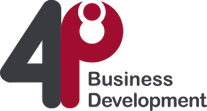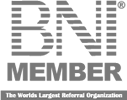Turnover is vanity, profit is sanity, cash is reality …
Listening to the news this past week, more and more businesses, small and large, are in trouble financially. It appears that they have all made one grave error …

If your customer base is growing but your profits are shrinking, you could be in trouble!
copyright: 4p business development
They’ve lost ‘A Grade’ customers and filled the gaps with many more ‘D Grade’ ones instead. Now they’ve got so much to do, they’re working all hours of the day and night, but for very little profit.
“I speak to a lot of business owners and managers!”
Some are new to business, and some very experienced; and I find that many just do not understand their real financial position.
It’s a common phrase: turnover is vanity, profit is sanity, cash is reality. You should be asking yourself these four key questions:
-
How much cash do we have in the bank?
-
What are our debtors and what are our liabilities?
-
What is the cash flow projection of this business?
-
What are my profit margins?
What’s the answer you may ask? Well, it’s not rocket science:
-
Understand your target market
-
Grade your customers A, B, C and D, where A = High Profit and D = Low Profit
-
Increase your prices
-
Reduce your costs
-
Get rid of the “D grade” customers
It is dangerous to believe everything you are told. Contrary to general belief, your customers will not leave you because of the price. The most significant cause of them leaving you is perceived indifference; that they think you do not care enough.
Your customers rely on their emotional experiences with more than any of the traditional factors, according to research by the Peppers & Rogers Group, which showed that:
-
60% of all customers stop dealing with a company because of what they perceive as indifference on the part of salespeople/service person
-
70% of customers leave a company because of poor service, which is usually attributed to a salesperson/service person
-
80% of defecting customers describe themselves as “satisfied” or “very satisfied” just before they leave
-
Customers who feel their salesperson/service person are exceptional are 10 to 15 times more likely to remain loyal.
If you raised your prices by 10% how many customers could you afford to lose, and how much time could you free up to take on more “A Grade” ones?
So now, with thanks to BizBuzz, let’s take a look at the top 7 financial drivers of profit and cashflow:
-
Revenue Growth Percentage
Most people think selling more is the way to fix a cash flow problem. Selling more can actually make cash flow problems worse! When you make a sale you need to ‘fund’ that sale, i.e. you need to pay for the stock/labour to deliver the sale, sometimes well before you’ve been paid by your customer. If you have a cash flow problem prior to sales growth it will get worse if you don’t concentrate on the other ‘drivers’.
-
Price Change Percentage
This means a price increase, decrease, or discount. Many small business owners think they can’t increase prices because they will lose customers. You can’t keep selling at the same price for years, absorbing increased costs, and be profitable. Most people understand prices go up. Wages and fuel go up constantly. You must monitor margins to see when it’s time to increase prices.
It’s reasonable to factor a small, regular increase into contracts. Use the opportunity of supplier increases to pass it on to customers. You don’t have to advertise that you’ve increased prices. CPI ranges around 2-3% and is hardly noticeable. If you don’t increase prices regularly, you will notice it when gross profit has reduced by 10% after years selling at the same price.
-
Cost of Goods (COGs) Percentage
This ‘driver’ is probably the most impactful. A small change here can have as much impact as a large increase in revenue. When you sell more, you incur more costs, stock, customers time to pay and jobs in progress prior to invoicing. When you reduce COGs it goes straight to your bottom line! I would recommend putting aside time to focus attention on reducing COGs and achieving efficiencies.
-
Overheads Percentage
Overheads are different to COGs as they occur all the time, e.g. rent, wages etc. COGs generally occur when you sell something, like a product or service. Overheads can ‘eat away’ at profitability if not kept in check. There’s one word for the solution here ‘budget’. There’s no better control than to put a budget into your accounting system and report every month on actual versus budget.
You can quickly identify issues and fix them to save yourself thousands of dollars rather than leaving it to the end of financial year, for tax accounts.
-
Accounts Receivable Days
This is the number of days ‘on average’ customers are taking to pay, if offered credit terms. This is different from the terms offered, e.g. 30 days. It’s not uncommon to see this result up to 120 days. There are many ways to get customers to pay on time, and regular efficient follow-ups is one.
-
Accounts Payable Days
This is the number of days ‘on average’ taken to pay suppliers, if terms are given. It’s common to see this number at less than the Accounts Receivable Days number. This means suppliers are paid quicker than collections from customers.
Not many people like chasing money, but are easily prodded into paying before terms allow. In this scenario, cash is going out to suppliers faster than it’s coming in from customers. The result? A cash squeeze!
-
Inventory and Work in Progress Days
Inventory Days is the number of days ‘on average’ stock sits in stock waiting to be sold. Work in Progress Days is the number of days jobs are in progress prior to invoicing.
Think of stock as dollar bills piled up on the stockroom floor, and Work in Progress as dollar bills piled up on the workroom floor! You need to have stock ready to sell when customers are ready to buy, but not for too long as it sucks up working capital. Sales forecasts and managing customer requirements are one way to minimise Inventory Days.
Work in Progress is made up of wages paid to staff/contract labour and materials on jobs. The longer it takes to complete jobs and then invoice, the more working capital is needed. Speeding up job management and reducing Work in Progress days will have a positive impact on cash. A great way to speed up jobs is to use systems, checklists and templates ensuring consistent quality. These tools reduce mistakes and wasted time. Improved Customer Satisfaction also speeds up payment.
Remember, turnover is vanity, profit is sanity, cash is reality so if you’re finding your profit shrinking as your customer base grows, call me on
01280 700405 or click here to ping me an email and let’s see how I can help you.
Until next time …

KATH BONNER-DUNHAM
|
PS: |
If you’re looking for a partner to help grow your business, visit www.4pbusinessdevelopment.co.uk to discover how 4P Business Development can help you! |










